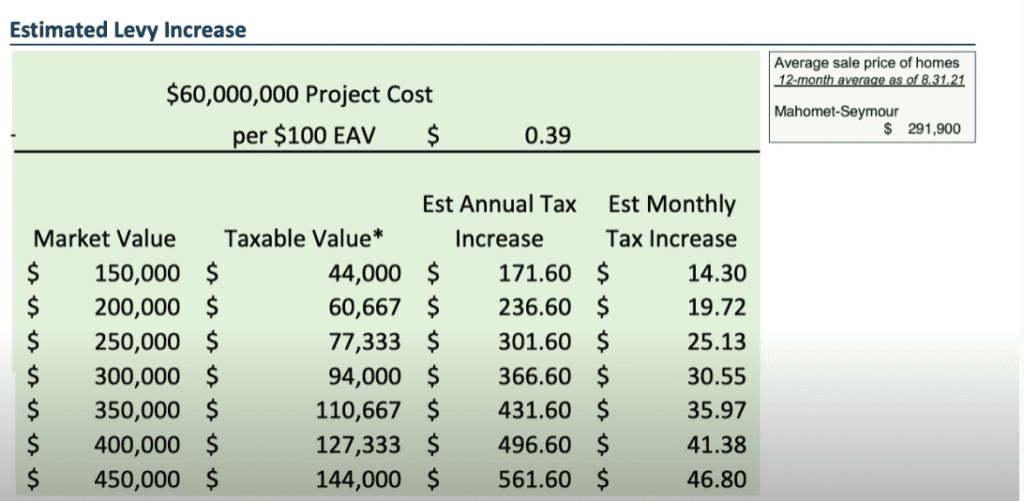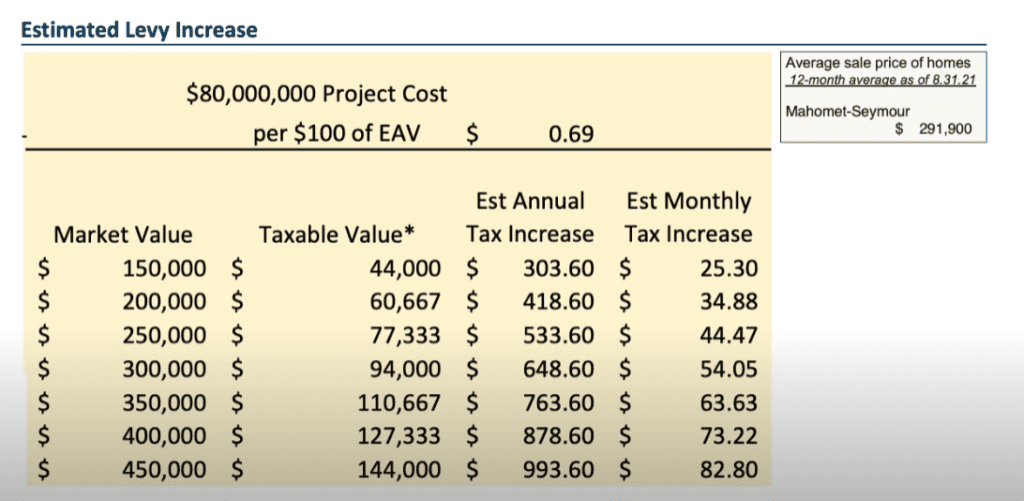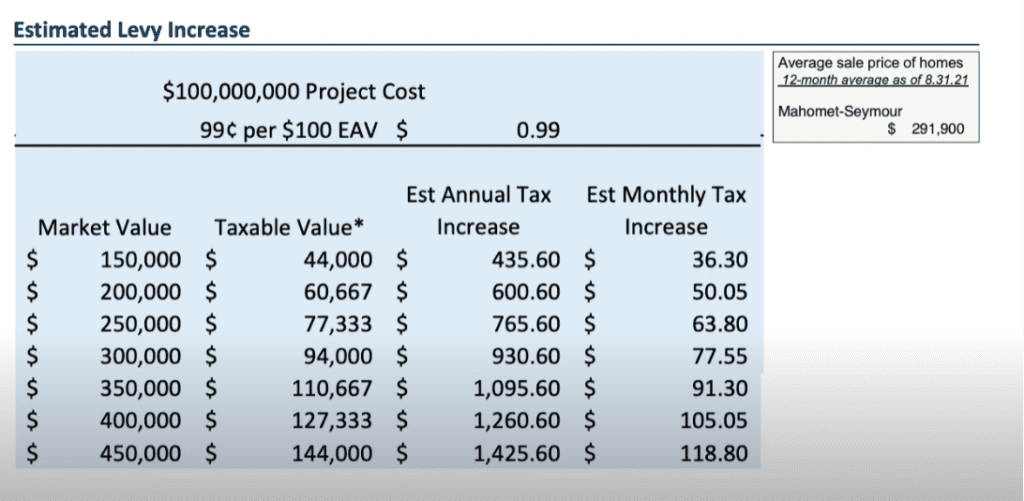The Mahomet-Seymour School District held the third session of its Bulldog Blueprint initiative with an in-person and an online session last week.
The six-session Bulldog Blueprint is billed as a community-led initiative to develop a facility improvement plan by June 2022 when the district will ask taxpayers to pass a referendum.
Kevin Heid, Managing Director of Public Finance at Stifel, began the session three presentation by looking at what the district would need from taxpayers to make the improvements possible.
He said that 2022 would be a good time to undertake additional construction projects seeing that interest rates are low, yet rates currently trend upward. Construction costs, which are at an all-time high due to product and labor shortages, continue to rise.
Heid presented three scenarios: a $60,000,000, $80,000,000 and $100,000,000 referendum. In the first Bulldog Blueprint session, it was estimated that in order to replace all four Mahomet-Seymour buildings, it would cost $175,000,000
Because the referendum would tax property values instead of using sales tax money like was used for Middletown Prairie Phase I and II, Heid highlighted what a tax increase for homeowners would look like based on their home value.
According to Zillow.com, the median home value in the 61853 zip code is $246,978, a 10-percent change from a year ago.
At $250,000 EAV, homeowners would see a $301.60 increase in property taxes over 20 years with a $60,000,000 referendum; a $533.60 increase in property taxes over 20 years with an $80,000,000 referendum; and a $765.60 increase in property taxes over 20 years with a $100,000,000 referendum.
Heid said that the $60,000,000 and $80,000,000 referendum would keep Mahomet-Seymour taxpayers with a $250,000 home under what taxpayers with the same home value, but with slightly higher tax rate pay in Champaign, Urbana, and Rantoul. The median home values in those communities are lower than Mahomet: Champaign ($171,000), Urbana ($150,984), Rantoul ($93,378). The $100,000,000 referendum would make that value of taxation nearly equal.



According to Illinois School Code, districts can add onto a building by issuing bonds without asking the taxpayer, if they have not hit their debt limit, but they cannot erect a free-standing building without passing a referendum.
Heid said that the Mahomet-Seymour School District still has about $10,335,000 in general obligation bonds that will be paid off by 2027. The District also holds six debt certificates from borrowing against projected Champaign County sales tax money, which should be reduced to $38,629,548 by Oct. 2021.
The student-population growth projections used for the Bulldog Blueprint only go until 2030 while the debt load would be carried out by taxpayers over two decades.
After a dip in enrollment from 2006-2009, Mahomet-Seymour enrollment has increased from 2704 to 3220 in 2020. A demographic study funded by the district and the Village of Mahomet projects that student enrollment will increase to 3583 by 2030.
Buildings in Mahomet-Seymour, including Middletown Prairie, which was completed in 2018, are over-capacity. Much of the focus leading up to session three of the Bulldog Blueprint focused on conditions at Mahomet-Seymour Junior High, which has been at capacity for a decade.
The district released two videos focusing on the experience of students and teachers at the junior high. Junior high teachers showed up to the in-person session three Bulldog Blueprint and were scattered among community members.
Other schools in the district are also experiencing the effects of a growing population. A grandmother talked about how students were assigned to classrooms designed for small groups at a joint Village and school district meeting in 2019. This year Mahomet-Seymour High School students have described overcrowded classrooms with 40-plus students, some without places to sit on the first day of school. Middletown Prairie hit capacity shortly after opening.
BLDD Architect Damien Schlitt, who is the district’s architect of record, said that most of the constituent feedback that the district received in sessions one and two focused on providing space for continued growth throughout the district.
All presented options included an addition of a bus barn, which has been projected to cost the district $2,300,000. Additionally, the only option that keeps the current junior high building in use is the status quo option.
The Mahomet-Seymour School Board is also currently considering giving possession of 13 Acres and Middletown Park to the Village of Mahomet. Taxpayer dollars, provided through a grant by the State of Illinois, could be used to build tennis courts at Middletown Park. The Village might then develop plans for 13 Acres after it takes possession.
This discussion should continue in October.
Without that land in play, the status quo option would add 55,000 onto the junior high’s 88,691 square feet, eliminating the track and soccer field on the property. Those facilities would be incorporated into the high school property where an eight-lane track, which was just resurfaced, and turf football field would be located. The extra-curricular amenities would be extended with a JV turf practice field/band field and a natural grass field. Art, choir, and band classrooms would be located in a 750-seat auditorium.
Inside the high school, those facilities would be turned into additional classroom space, leaving the high school at 240,345 square-feet, 35,000 additional.
Lincoln Trail would get approximately 25,000 additional square feet of classroom space and Middletown Prairie would get 13,000.
Some community members asked to see a plan for a new high school, moving the junior high into the current high school building. Schlitt said the need for 100-additional acres would require the district to acquire land, preferably land with utilities.
This scenario would add the same square footage onto Middletown Prairie and Lincoln Trail as was presented in the status quo scenario, but would increase the square footage for junior high students by 61,654 square feet. The high school would also see a square footage gain from the status quo option by 59,656 (300,000 square feet).
The second scenario presented shows a new junior high being erected on the south lots of the current Middletown Prairie Elementary property. The district owns about 55 acres there. That land will be split into three sectors, a 32-acre lot, a 16-acre lot and a 5-acre drainage lot when South Mahomet Road is extended across the property.
Schlitt presented a 140,000 square foot Mahomet-Seymour Junior High to house students in grades 6-8 on that land. Baseball and softball fields would also be located at this site. Mahomet-Seymour High School, Middletown Prairie, and Lincoln Trail would still get the upgrades presented in the status quo example.
The third scenario presented by BLDD would put a 165,000 square-foot building on the Middletown Prairie property, but this building would house students in grades 5-8. Lincoln Trail would remain a 3-4 building, and would not receive any updates.
The intermediate building, 5-8, would function with a fifth and sixth-grade wing and a seventh and eighth-grade wing that shares resources. Baseball and softball fields would also be located at this site.
The district took feedback for session three until noon on Sept. 28. In the past, the district has posted feedback on the Bulldog Blueprint website. The next sessions will be held on Oct. 19 (in-person) and on Oct. 21 (virtual).




I attended the virtual session and the group I was in thought it was a bad idea to separate the junior high and high school. Why can’t we build a new junior high adjacent to the current junior high in phases (and then demolish the old building), upgrade all the schools for anticipated growth beyond 2030 and sell the land near MPE to help pay for the upgrades and new construction? In Mr. Schlitt’s presentation, he admitted this referendum would only support a temporary change, and more would need to be done in the future. I can’t support a plan that will take 3-5 years to complete, and by then we will be three years away from projected capacity AGAIN. That is truly poor planning. There are other better options to consider than those presented at the Blueprint meetings. We should continue to work toward better solutions and not rush to a decision that won’t ultimately help to improve classroom conditions due to overcrowding for our students. We will be in the same situation we are in now in only a few years past when this plan will be executed. And we will still be paying for it for another decade or more!